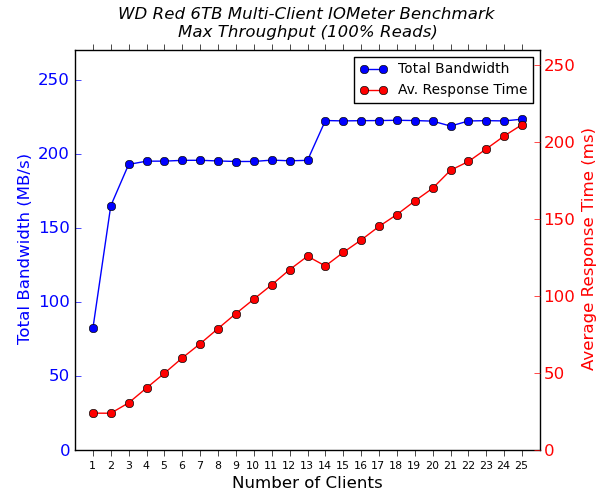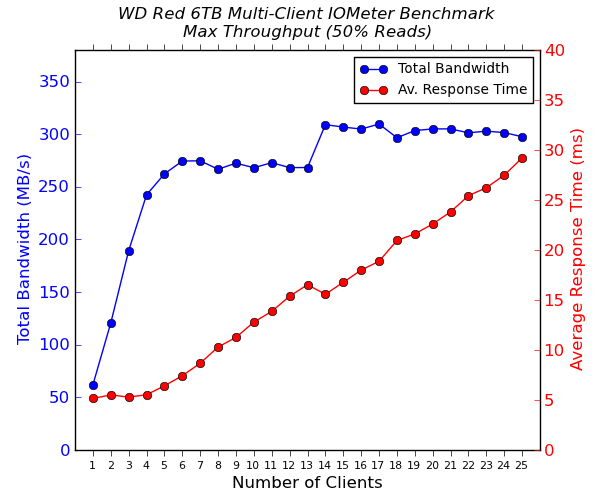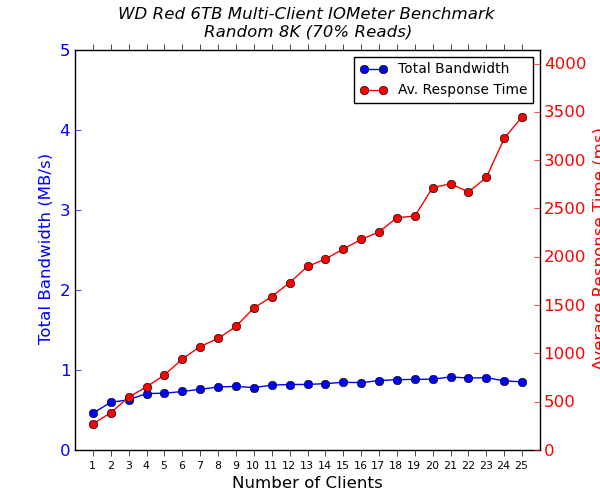6 TB NAS Drives: WD Red, Seagate Enterprise Capacity and HGST Ultrastar He6 Face-Off
by Ganesh T S on July 21, 2014 11:00 AM ESTMulti-Client Access - NAS Environment
We put the NAS drives in the QNAP TS-EC1279U-SAS-RP through some IOMeter tests with a CIFS share being accessed from up to 25 VMs simultaneously. The following four graphs show the total available bandwidth and the average response time while being subject to different types of workloads through IOMeter. IOMeter also reports various other metrics of interest such as maximum response time, read and write IOPS, separate read and write bandwidth figures etc. Some of the interesting aspects from our IOMeter benchmarking run can be found here (WD Red 6TB), here (HGST Ultrastar He6) and here (Seagate Enterprise Capacity v4 6 TB).




These tests reveal the shortcoming of the low rotational speeds of the WD Red. Random accesses from multiple clients can cause the performance to drop considerably, while the Seagate enterprise drive manages to hold its own. However, the good aspect is that the WD Red's target market (SOHO / home consumers) will not have these many concurrent accesses. The type of workload is also expected to be mostly sequential in nature. For those test cases, the Red 6 TB version manages to perform as expected.










83 Comments
View All Comments
ganeshts - Tuesday, July 22, 2014 - link
There is no 6 TB WD Red Pro out in the market. The Pro version tops out at 4 TB (for now) - 800 GB x 5 plattersharshw - Monday, July 21, 2014 - link
This week I had a LaCie 5Big NAS Pro barf on my 4TB Seagate NAS HDDs. Reformatting and re-testing them with sector scans revealed nothing. But the LaCie would claim that one disk was bad. Of course LaCie also claims the 4TB NAS HDDs are completely compatible.But to have a 16TB array die after re-synching 80% and having to start from scratch ... yeah it plain sucks.
So yes, it is best to look at evidence from the field and not just rely on manufacturer's recommended & compatible lists. And it's not just WD Red ...
Hrel - Monday, July 21, 2014 - link
It's frustrating that despite the rapid growth in the NAS industry hard drive prices have remained largely stagnant. 4TB drives are basically at the same price point's they were a year ago. It used to be if a drive was released at $200 a year later it was $100 or less.I'm still waiting for 4TB drives to drop to the $100 mark before I make the jump.
What happened to all those 121TB hard drives that we were supposed to be seeing? I specifically remember an article on anandtech like 1+ years ago talking about how 12TB hard drives would be a reality "a year from today". More than a year later, we're talking about 6TB drives. Very upsetting.
Beany2013 - Tuesday, July 22, 2014 - link
The floods in Thialand a few years ago set things back - we're only now seeing the manufacturers get their primary build locations back up to full speed not just in manufacturing existing gear, but developing new stuff.We've had 2tb drives for *years*, but 3tb and above are the results of the 'HDD Homelands' getting back up to speed as I understand it from my works disty/channel contacts, at least. Mebbe one for a pipeline article on the stagnation of HDD capacity, staffers?
extide - Monday, July 21, 2014 - link
When are we going to get 4k native drives!! I hate this stupid 512b emulation crap!Zan Lynx - Monday, July 21, 2014 - link
I am pretty sure 4K native drives are already out there. I recall a Linux Kernel message thread discussing testing 4K drives and there was a tool to turn off 512B emulation.If you want them to turn off emulation, I doubt that will happen. Its too easy to leave the code in the firmware.
edlee - Monday, July 21, 2014 - link
seagate wipes the floor with all other manufactures when it comes to enterprise products.that being said, they are expensive as shit, so I bought WD red for my home Nas, but use seagate in my office server for reliability.
jabber - Monday, July 21, 2014 - link
Liabilities waiting to happen.asmian - Monday, July 21, 2014 - link
Completely agree! The two enterprise-class drives are just about OK to use in arrays (and the Helium tech of the HGST looks very interesting, I hope they bring that to smaller drives as well) but the WD Red at that size is a crazy proposition. See my calculation about the risks of rebuilding arrays with those at http://anandtech.com/comments/8273/western-digital...Anybody building large arrays with these consumer-class 6TB Reds is a fool.
bsd228 - Monday, July 21, 2014 - link
Asmian - you may be taking that URE value too literally. I find it very hard to believe that enterprise drives are exactly 10x as good as consumer drives. When the number is so round as 1x10^14 or 1x10^15, it makes me believe them the same way I do the MTBF values. Consider how many premium or enterprise products we see where the only different is a software setting activating a feature.